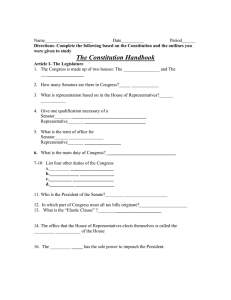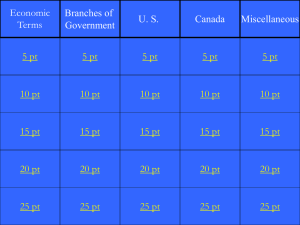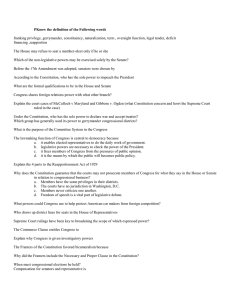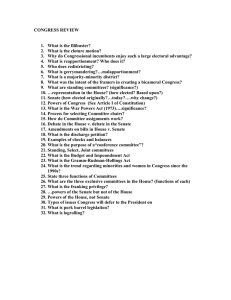Group 1 Review Questions
advertisement
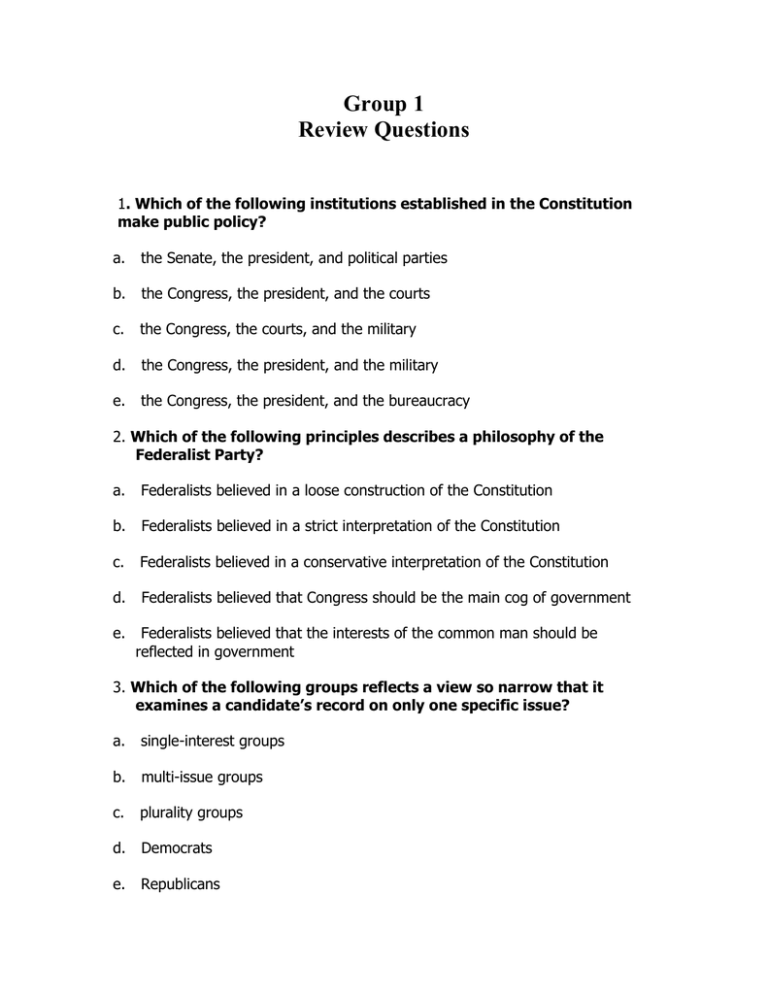
Group 1 Review Questions 1. Which of the following institutions established in the Constitution make public policy? a. the Senate, the president, and political parties b. the Congress, the president, and the courts c. the Congress, the courts, and the military d. the Congress, the president, and the military e. the Congress, the president, and the bureaucracy 2. Which of the following principles describes a philosophy of the Federalist Party? a. Federalists believed in a loose construction of the Constitution b. Federalists believed in a strict interpretation of the Constitution c. Federalists believed in a conservative interpretation of the Constitution d. Federalists believed that Congress should be the main cog of government e. Federalists believed that the interests of the common man should be reflected in government 3. Which of the following groups reflects a view so narrow that it examines a candidate’s record on only one specific issue? a. single-interest groups b. multi-issue groups c. plurality groups d. Democrats e. Republicans 4. Which of the following institutions is commonly called the fourth branch of government? a. the bureaucracy b. the media c. the Internal Revenue Service d. the CIA e. the FBI 5. Which of the following principles is most fundamental to democratic theory? a. free elections b. minority rules c. civil rights d. political parties e. a written constitution 6. Which of the following theories claims that too many competing groups cripple government’s ability to govern? a. hyper-pluralist theory b. pluralist theory c. elite theory d. democratic theory e. class-based theory 7. John Locke’s Second Treatise of Civil Government advocates a. a divine monarchy b. rights for the minority c. majority rights d. natural rights e. democratic rule 8. When the Articles of Confederation were adopted, the nation’s major concern was dominated by a. slavery b. religious freedom c. equality for women d. political dominance by the central government e. economic issues 9. Which of the following statements best describes the Articles of Confederation? I. domination of the government by the states II. a national congress with one house and no executive III. no national court system IV. no ability of the central government to enforce the collection of taxes a. I only b. I and II only c. I, II, and III only d. I and IV only e. I, II, III, and IV 10. Which of the following documents created a compromise that led to the formation of a bicameral legislature? a. Articles of Confederation b. Connecticut Compromise c. New Jersey Plan d. Virginia Plan e. Three-Fifths Compromise 11. The national government under the Articles of Confederation a. consisted of three branches b. promoted unity among the states c. had a bicameral legislature d. consisted of a unicameral legislature e. required unanimous passage of all legislation Group 2 M/C review Questions 1. A major concern of the Anti-Federalists involved a. their desire to strengthen the central government b. their fear that the states would maintain their dominance under the new government c. their fear that foreign governments would try to overpower the new nation d. their belief that a strong chief executive was necessary e. their desire to see a bill of rights guaranteeing individual protections added to the Constitution 2. Under a federal system of government, all of the following are TRUE EXCEPT a. local matters are largely handled on a local level b. national matters are the responsibility of the federal government c. federal and state governments have powers that sometimes overlap d. in cases where powers are in conflict, the state government is supreme e. in cases where powers are in conflict, the national government is supreme 3.The system under which each branch can limit the actions of the other branches is called a. separation of powers b. checks and balances d. limited government e. representative government c. federalism 4. The section of the Constitution that clearly states the concept of federalism is a. Article I B. Article II d. the 10th Amendment e. the Preamble c. Article III 5. Under the system of checks and balances, all of the following are allowed EXCEPT a. the Senate’s refusal to approve the president’s appointment of a justice to the Supreme Court b. the Senate’s refusal to ratify a treaty negotiated by the president and his foreign policy advisors c. the Senate’s dismissal of a Cabinet member accused of accepting bribes d. the president’s lobbying for a new crime bill to be passed in Congress e. the Supreme Court’s ruling that an executive order is unconstitutional 6. Which of the following governmental bodies is most directly responsible to the electorate? a. the House of Representatives b. the Senate c. the executive branch d. the Supreme Court e. the bureaucracy 7. The practice of judicial review was first established by which of the following actions? a. the Constitution gives life terms to Supreme Court Justices b. Justices serve as long as they maintain good behavior c. The Supreme Court exercises judicial precedent d. The Supreme Court has appellate jurisdiction e. The Supreme Court can declare a congressional act unconstitutional 8. Which of the following resulted after the Supreme Court made a ruling in Baker v Carr? a. The principle of “one man, one vote” was established b. Congressional districts became gerrymandered based on political considerations c. Congressional districts were created as a result of racial considerations d. State legislatures modified existing voting districts for state offices e. Congress was able to modify congressional districts in states where there was not equal representation 9. All of the following are considered enumerated powers of Congress EXCEPT a. coining United States currency after the Constitution was ratified b. establishing inferior courts in addition to the Supreme Court c. setting up the first National Bank of the U.S. d. establishing uniform immigration laws in the 1920’s e. regulating commerce among the several states 10. The implied powers clause in the Constitution has been describes as the ability of Congress to take which of the following actions? a. pass an assault weapons ban b. withdraw funds allocated to troops in Haiti c. pass a balanced budget amendment to the Constitution d. raise the price of stamps to 32 cents e. passing a law setting quotas for immigrants 11. All of the following represent examples of limited government EXCEPT a. the application of habeas corpus in criminal appeals b. the prohibition of passage of bills of attainder laws c. Congress not being allowed to pass ex post facto laws d. The inability of the president to grant titles of nobility e. The Reserved Power Clause of the 10th Amendment Group 3 Review Questions 1. The chairman of the standing committees of Congress are chosen a. by the voters b. according to a strict seniority system c. by the president d. by the leaders of both political parties e. by the leaders of the majority party 2. Bills may be introduced in either house of Congress with the exception of ____ bills, which must originate in the House of Representatives. a. agricultural b. revenue c. foreign aid d. military e. education 3. Article I grants Congress the power to do all of the following EXCEPT a. declare war b. collect taxes c. appoint federal judges d. regulate interstate commerce e. establish federal courts 4. The “elastic clause” grants Congress a. delegate powers b. inherent powers c. implied powers d. expressed powers e. war powers 5. Permanent committees dealing with such matters as agriculture, finance, and foreign policy are know as a. select committees b. conference committees c. joint committees d. standing committees e. ad hoc committees 6. The House Committee that acts like a “clearing house” for the thousands of bills introduced each term is called the a. Rules Committee b. Ways and Means Committee c. Steering Committee d. Legislative Committee e. Clearing Committee 7. Constitutional Amendments must pass in both houses of Congress by a. simple majority b. 3/5ths majority c. 2/3 majority d. ¾ majority e. unanimous consent 8. The use of the filibuster, a tactic to block the passage of legislation, a. has been declared unconstitutional by the Supreme Court b. is allowed in both the House and the Senate c. can be ended by a majority vote d. was used in the 1950’s and 1960’s to stall civil rights legislation e. Is illegal in most states 9. The number of members in the House of Representatives a. changes after each national census b. was fixed at 435 by the Constitution c. is based on an equal number from each house d. was fixed at 435 by the Reapportionment Act of 1929 e. was fixed at 435 by a constitutional amendment 10. The qualifications for members of the House of Representatives are found in Article I of the Constitution. All of the following are requirements for a House member EXCEPT a. must be 25 years old b. must be an American citizen for 7 years c. must be a resident from the state represented d. can be a naturalized citizen e. can not serve for more than 2 consecutive terms 11. Which of the following factors generates the most significant advantage for a Congressional candidate? a. being wealthier than the opponent b. getting the most press coverage c. being invited to the most town meetings d. being an incumbent e. taking positions on key social issues 12. Which of the following functions of senators and representatives would be the most important to their constituents? a. attending political fund raisers b. networking with lobbyists c. accepting PAC money d. recommending a high school student to one of the military academies e. making a speech about national defense that is printed in the Congressional Record 13. Senators and representatives are often criticized for making deals with other legislators or the president in order to get programs, projects, and grants moving along the legislative process. What is this legislation called? a. constituent laws b. rider legislation c. logrolling d. pork barrel legislation e. legislative veto 14. Which of the following represents an indirect consequence of a bicameral legislature? I. Gridlock may take place II. Political compromise can take place III. An additional check and balance takes place IV. There is usually a tremendous decrease in lawmaking ability a. I only b. II only c. II and III only d. II and IV only e. I, II, and III only 15. Which of the following House committees is responsible for setting the agenda for legislation coming to the floor? a. Rules Committee b. Ways and Means Committee c. Appropriations Committee d. The Policy Committee e. The Armed Services Committee Group 4 Review Questions 1. Even though the Congress is primarily responsible for legislation, each house also has specific non-legislative responsibilities. Which of the following represents a specific Senate responsibility different than the House? I. ratifying all treaties II. confirming presidential appointments III. trying to impeach officials IV. introducing all appropriation legislation a. I only b. II and III only c. IV only d. I, II, and III only e. I and IV only 2. Which of the following individuals presides over the House of Representatives? a. the House minority leader b. the House Pro Tem c. the House Majority Leader d. the Speaker of the House e. the House Majority Whip 3. The Speaker of the House has many responsibilities. All the following reflect roles that the speaker plays EXCEPT a. acting as chief presiding officer of the House b. serving as third in line in presidential succession c. making committee assignments for both houses d. playing a key role in appointing committee chairs e. working hand in hand with the president relating to the legislative agenda if they are both from the same party 4. All of the following are examples of congressional oversight committees EXCEPT a. the Banking Committee holding Whitewater hearings b. the Select Committee on Campaign Activities to investigate campaign abuses c. the House Judiciary Committee’s hearing on the impeachment of President Nixon d. the Select Senate Watergate Committee e. the Select Iran-Contra Committee 5. Pork barrel legislation helps the reelection chances of a member of Congress because such legislation a. gives the member of Congress national standing and coverage on national television news b. helps earn the member of Congress a reputation for service to his or her district c. attracts campaign contributions from ideological political action committees d. prevents other candidates from claiming that the member of Congress is too liberal for his or her district e. required the member of Congress to travel extensively 6. Characteristics of executive agreements include all of the following EXCEPT a. they are similar to treaties b. they must be ratified by the Senate c. they must be related to treaties previously negotiated d. presidents use them to circumvent the Senate e. they were used extensively to conduct the war in Vietnam 7. The War Powers Act of 1973 a. enlarges the president’s power to commit troops to foreign soil b. calls for the president to notify Congress within 24 hours of ordering military forces into operation c. prohibits the president from leaving troops engaged in combat for more than 30 days without authorization from Congress d. had crippled the president’s power to exercise his constitutional military powers e. prohibits the president from leaving troops engaged in conflict for more than 60 days without authorization from Congress 8. All of the following are TRUE of the 25th Amendment EXCEPT that a. it allows the president to appoint a vice-president if a vacancy exists b. it allows the president to name a successor of his own choice if he leaves office immediately c. it provides for the vice-president to serve as acting president if the president is temporarily incapacitated d. it was invoked by President Nixon when Vice-President Agnew resigned from office e. under its terms Gerald Ford became the first appointed president 9. The president’s constitutional duties include all of the following EXCEPT a. negotiating treaties b. granting pardons and reprieves in federal cases c. passing legislation d. appointing high ranking federal officials e. executing the laws 10. Candidates for the offices of president and vice-president a. must be at least 30 years of age b. must run in all the presidential primaries c. must be lifelong residents of the U.S. d. must be native-born citizens e. must be members of an established political party 11. The Electoral College a. functions largely independent of the major political parties b. provides for a winner-take-all system of election in all 50 states c. d. e. requires that the candidate who receives a plurality of the votes will be elected to the office of president meets continuously until a president is chosen requires that a candidate receive a majority of 270 electoral votes in order to be elected 12. Using the bully pulpit refers to a president a. using the power and influence of his office to exert pressure b. calling upon members of his cabinet to influence legislation c. using his veto power to reject legislation d. signing a piece of legislation into law e. taking a trip to a foreign country to sign a treaty 13. Which of the following is responsible for the preparation of executive spending proposals submitted to Congress? a. Treasury Department b. Council of Economic Advisors c. Federal Trade Commission d. Department of Commerce e. Office of Management and Budget 14. Which of the following methods is/are used by a president who wants to persuade recalcitrant members of Congress to vote for a particular bill? a. transfers members who oppose the bill to unpopular committees b. denies campaign funds to members who oppose the bill c. threatens to deny re-nomination to members who oppose the bill d. threatens to veto a different bill that enjoys bipartisan support in Congress e. makes a direct appeal to the public Group 5 Review Questions 1. The dual court system refers to a. the district courts and the federal appeals courts b. the constitutional and the legislative courts c. civil and criminal courts d. the Supreme Court and the U.S. Courts of Appeals e. separate federal and state court systems 2. The term stare decisis means a. separate but equal b. let the decision stand c. judicial review d. a concurring opinion e. original jurisdiction 3. The Supreme Court’s jurisdiction encompasses all of the following situations EXCEPT a. a case involving an ambassador b. review of a federal executive order c. review of a piece of federal legislation d. a Secret Service agent suspected of internal espionage e. a case in which a state is a party 4. The procedure of judicial review was clearly established in a. Article III of the Constitution b. Plessy v Ferguson c. Marbury v Madison d. The Preamble to the Constitution e. Brown v Board of Education 5. Which represents a major reason for the submittal of an amicus curiae brief? a. the Court must rely on precedent cases b. a friend of the court wishes to provide additional information to the Court c. lower courts must provide transcripts of its decisions d. the Supreme Court requires related interests in the case to submit briefs e. the brief from the petitioner provides amended information about the case 6. All of the following are TRUE of the administrators of the regulatory commissions EXCEPT a. they are appointed by the president b. they must be approved by the Senate c. they are expected to be non-political in their recommendations d. they can be dismissed by the president e. they serve for a fixed number of years 7. Which of the following is the best indicator of the Department of Defense’s yearly budget” a. the desire of the chairman of the Senate Armed Services Committee b. the budget recommendation of the Joint Chiefs of Staff c. the rate of increase of the size of the armed forces d. the number of bases being closed e. the size of the budget from the year before 8. The theoretical bureaucratic structure includes all of the following EXCEPT a. a hierarchical authority structure b. a spoils system c. extensive rules d. standard operating procedures e. a division of labor 9. Administrative regulations contain all of the following elements EXCEPT a. a grant of power and a set of directions from Congress b. a set of rules and guidelines by the regulatory agency itself c. power granted to the Justice Department to enforce heavy sanctions, including abolishing the agency d. a means of enforcing compliance with congressional goals and agency regulations e. a set of penalties for noncompliance 10. When a president tries to control a bureaucratic agency, all of the following methods are available to him EXCEPT a. appointing the right people to head the agency b. reducing the agency’s budget c. issuing executive orders to counteract agency policies d. recommending a reduction of the agency’s budget the following year e. using his office to influence agency direction 11. Which of the following results with iron triangle relationships? a. each policy being made independently of the others b. policies being made that are contradictory to others c. a lack of an integrated, coherent approach to broad policy problems d. a cooperative relationship among the bureaucratic agencies making policy e. a hostile relationship among the bureaucratic agencies making policy Group 6 Review Questions 1. With reference to political parties, the Constitution a. provided a general framework for their development b. made no mention of them c. provided a detailed plan for their organization d. specified Congress to be organized along party lines e. had to be amended to allow for their development 2. A type of election that encourages voters to support weak candidates is the a. open primary b. closed primary c. crossover primary d. “off year” election e. party caucus 3. All of the following are functions of political parties EXCEPT a. communicating with the electorate b. getting its message to the media c. operating as an organization d. establishing its role in government e. recruiting members from the bureaucracy 4. In the long history of the American party system, successful parties rarely stray from a. a solid conservative foundation b. a slightly liberal point of view c. a slightly conservative point of view d. the midpoint of public opinion e. a reactionary point of view 5. Which of the following best describes the nature of American political parties? a. America is a one-party system with two branches b. American is a multi-party system c. Two parties have always dominated d. American has always had a three-party system with the third party rarely having an impact on the two major parties e. American political parties are dominated by extreme ideology 6. Which of the following choices helps shape the self-proclaimed preference for one or the other party? a. ideology b. identification c. socialization d. dealignment e. realignment 7. Which of the following is an example of a single interest group? a. National Right to Life Committee b. Greenpeace c. National Education Association d. American Medical Association e. National Organization for Women 8. Political Action Committees a. have roots that originated in the 19th century b. have declined in popularity in recent years c. may contribute up to $1000 a year to a political candidate d+ e. may make unlimited contributions to political candidates 9. The principal function of a pressure group is to a. provide campaign money to candidates for public office who favor its programs b. draw media attention to its cause c. obtain favorable policies from government for the cause it supports d. win congressional seats for its members e. accomplish all the above 10. All of the following statements concerning interest groups are TRUE EXCEPT a. interest groups are policy experts b. interest groups attempt to appeal to a broad spectrum of political interests c. interest groups often run their own candidates for public office d. interest groups lobby different levels of government e. interest groups have specific policy goals 11. Which of the following represents a major reason for the proliferation of special interests and lobby groups? a. the reactive nature of interest groups and lobbyists to new issues b. the increase in donations received by interest groups from their members c. the trust citizens have in the legislative process d. the ability of lobbyists and special interest groups to get members from their own group to run for political office e. the increasing demand for campaign reform 12. A significant amount of PAC money most likely goes to a. candidates challenging Republican seats b. candidates challenging Democratic seats c. candidates who are new to the political scene d. candidates who have a wide philosophical differences with the PAC e. candidates who hold incumbent status 13. The major impact of the Federal Election Campaign Act of 1974 was that a. it eliminated lobbyist gifts and vacations for legislators b. it set strict contribution limitations for congressional campaigns c. it created matching funds for congressional campaigns d. it legitimized and increased the number of interest groups e. it created strict registration procedures for lobbyists 14. If presidential candidates accept federal support in the form of matching campaign financing, then they a. are no longer required to disclose their contributions b. agree to limit their campaign expenditures to an amount prescribed by federal law c. no longer have any limit to their campaign expenditures d. are no longer required to disclose how they spend their money e. no longer can accept PAC money 15. The least important agent in molding public opinion among the young would probably be a. older family members b. school curriculum c. peer group members d. socio-economic groups e. religious role models 16. Which of the following factors is probably most significant in determining how an individual will vote in a presidential election? a. occupation e. religion b. income level c. party loyalty d. geography


